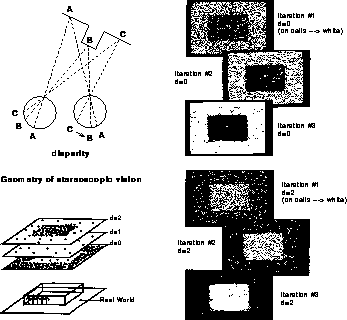




Next: 7 Independent Parallelism
Up: 6 Synchronous Applications II
Previous: 6.7.3 Conclusions
The collective stereopsis algorithm described in
[Marr:76a] was historically one of the first ``cooperative''
algorithms based on relaxation proposed for early vision.
The goal in stereopsis is to measure the difference in retinal position
(disparity) of features of a scene observed with two eyes (or
video cameras). This is achieved by placing a fiber of ``neurons''
(one for each disparity value) at each pixel position. Each neuron
inhibits neurons of different disparities at the same location (because
the disparity is unique) and excites neurons of the same disparity at
near location (because disparity tends to vary smoothly). After,
convergence the activation pattern corresponds to
the disparity field defined above.

Figure 6.44: Collective Stereopsis: (top left) Definition for geometry of
stereoscopic vision. (bottom left) Neural Network Activity (top three
layers disparity d=0, 1, 2) corresponding to real world
structure illustrated. (right) Results of iterations for d=0 and
d=2 layers of neurons. d measures disparity value for pixels.
The parallel implementation is based on a straightforward domain
decomposition and the results are illustrated in
Figure 6.44. They show the initial state of disparity
computation and the evolution in time of the different layers of
disparity neurons. Details are described in [Battiti:88a].
Other References
HPFA Applications
Guy Robinson
Wed Mar 1 10:19:35 EST 1995





